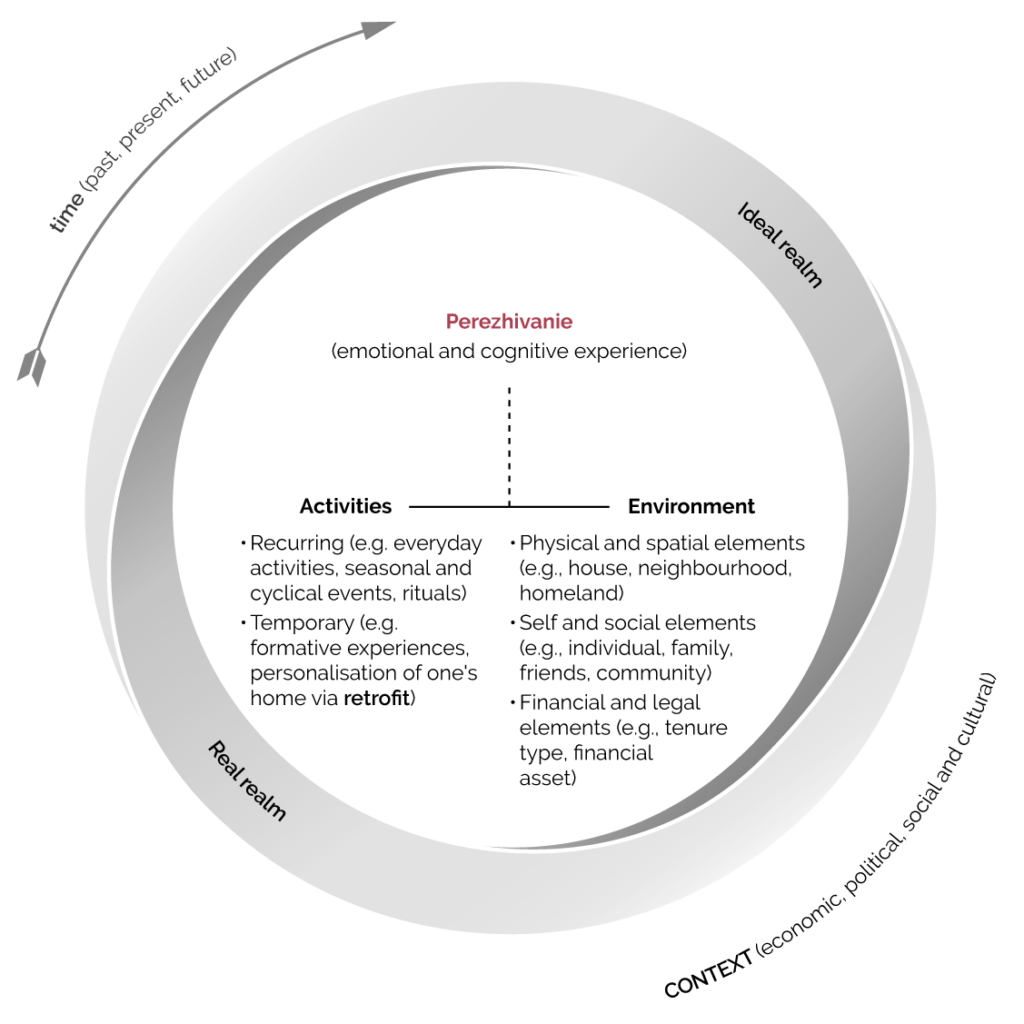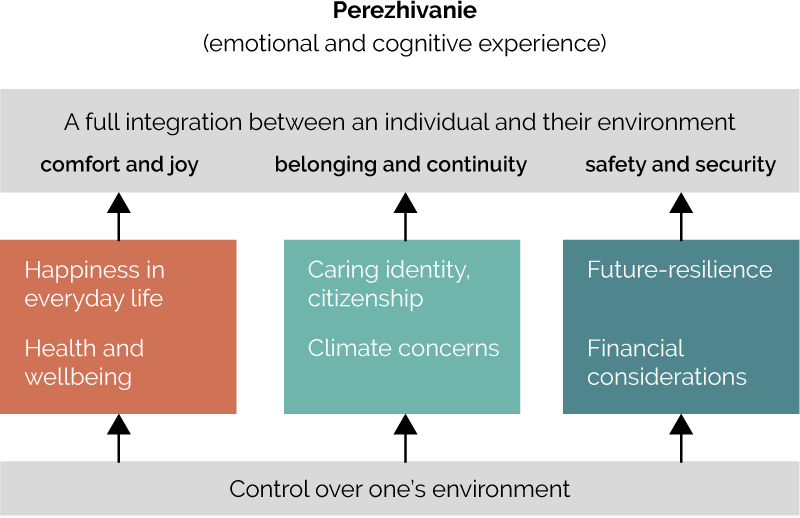How can energy policy encourage retrofit of domestic buildings? By getting emotional, says Yekatherina Bobrova.
Home is a place of a great emotional significance for individuals. Thus, we should use both cognitive and emotional reasoning to motivate energy retrofit. In this work we use home-meanings to understand the emotional end of the decision spectrum.
The domestic energy sector accounts for just under a third of total energy use in the UK, most of which is attributed to heating. Thus, it is important that energy policy encourages the energy retrofit of dwellings, particularly among homeowners, as 70% of the domestic building stock is owner-occupied.
Energy policy typically uses cognitive (logical) reasons to motivate energy retrofit decisions, such as: “It will save you money, through a reduction in energy bills. It will save the planet. And there will be some health benefits to you, as a result of improved thermal comfort and indoor air quality”.
However, home is a place of a great emotional significance for individuals, and it has been argued that the whole spectrum of reasoning — both cognitive and emotional — should be used to motivate energy retrofit. It has been argued that homeowner energy retrofit motivations should be understood within broader meanings people attach to their homes. The research presented in this blog aimed to fill this gap.
Contextualising benefits of low-carbon dwellings within home-meanings
We carried out a critical literature review to develop a conceptual framework of home-meanings (Figure 1). We identified five dimensions of home-meanings: (1) the diversity of psychological and social values and attributes, such as the feelings of comfort, belonging and security. We used the concept of perezhivanie (emotional and cognitive experiences), which is well-established in cognitive developmental psychology, to capture the relationship between this first theme with the next two – (2) environment and (3) activities. This is because the concept of perezhivanie suggests that emotional and cognitive experiences should be understood through the unity of one’s environment and activities. The framework also acknowledges the importance of (4) real and ideal realms and (5) time in shaping home-meanings.

Figure 1 image description
Perezhivanie (emotional and cognitive experience) is underpinned by: Activities – Recurring (e.g. everyday activities, seasonal and cyclical events, rituals), Temporary (e.g. formative experiences, personalisation of one’s home via retrofit); and Environment: Physical and spatial elements (e.g. house, neighbourhood, homeland), Self and social elements (e.g. individual, family, friends, community), Financial and legal elements (e.g. tenure type, financial asset).
These are enclosed in ideal and real realms, which are influenced by time (past, present, future) and context (economic, political, social and cultural).
We then proceeded to identify positive emotional and cognitive experiences associated with low-carbon dwellings in particular (Figure 2). We backgrounded our theoretical construction by drawing upon the critical literature review on home-meanings and empirical insights from 18 case studies, in ten of which homeowners achieved significant carbon emission reductions through retrofit activities, while in eight they did not.
The identified positive experiences were organised in five themes:
- Control over one’s environment, as a well-constructed low-carbon dwelling allows more control to achieve the desired indoor environment.
- Health and well-being & Happiness in everyday life, as a low-carbon dwelling provides a better platform to be happy in one’s home, given the increased control to achieve the desired indoor environment. How happiness is manifested will differ from individual to individual, ranging from reading a book in solitude to entertaining guests. A low-carbon dwelling will provide a better platform to achieve whatever the desired goal is.
- Climate concerns & Caring identity, highlighting that the notion of a ‘low-carbon home’ is linked to an identity of a broader social responsibility. When asked about their low-carbon homes, interviewees talked about citizenship, the responsibility they felt, being concerned, conscious, considerate and helping something bigger.
- Financial considerations & Future-resilience, highlighting that a low carbon dwelling affords resilience against volatility of energy prices, political volatility and, indeed, climate change.
- A full integration between an individual and their environment, which is the ultimate desired outcome in one’s home. For a low-carbon dwelling, this unifying outcome can manifest in:
-
- feelings of joy, happiness and comfort in a cosy, warm place with a healthy indoor environment,
- feelings of belonging and continuity, as the identity of one’s home becomes interlinked with the identities of its inhabitants with time,
- feelings of safety and security in a place that one thinks is future-resilient.

Figure 2 image description
Perezhivanie (emotional and cognitive experience). Control over one’s environment feeds into each of three boxes:
- 1 comfort and joy which includes happiness in everyday life, and health and wellbeing
- 2 belonging and continuity which includes caring identity, citizenship, and climate concerns
- and 3 safety and security which includes future-resilience and financial considerations.
The three boxes then lead to a full integration between an individual and their environment.
How to use home-meanings to motivate energy retrofit
To build emotionally and cognitively compelling narratives to encourage domestic energy retrofit, we suggest showing how the five themes of positive emotional and cognitive experiences (perezhivanie) associated with low-carbon dwellings (Figure 2) emerge in the interaction between one’s environment and activities. Ideally, all five dimensions of the home-meanings framework (Figure 1) should be considered when building a narrative.
For this project, we held a stakeholder workshop with 36 participants, representing various actors interested in advancing domestic energy retrofit activities in the UK including industry, government, academia and intermediaries. The participants were asked to use the developed frameworks to a variety of motivational narratives for energy retrofit. The participants found the concept of perezhivanie especially helpful to aid their thinking.
Home for the Common Future (HCF) heuristic
Finally, we developed a Home for the Common Future (HCF) heuristic to help stakeholders promote the benefits of low-carbon dwelling to homeowners by building compelling narratives. The heuristic captures only three out of five themes of emotional and cognitive experiences described in Figure 2, as the themes of ‘control over one’s environment’ and ‘a full integration of an individual and their environment’ are implicit in achieving positive experiences associated with low-carbon dwellings. The simplification also helps to crystallise the core argument and aid communication of the idea. To convey the underlying rationale, emotional and cognitive reasoning are separated out. Emotional experiences include: (i) Happiness in everyday life, (ii) Caring identity, (iii) Future-resilience. Cognitive experiences include: (i) Health and well-being, (ii) Climate concerns, (iii) Financial considerations. The three themes are synthesised into a single heuristic – Home for the Common Future (HCF). The acronym HCF can simultaneously be used to refer to the heuristic itself, or to separately describe motivations involving emotional and cognitive reasoning (Figure 3).
We wholeheartedly encourage the use of the HCF heuristic!

Figure 3 image description
Home for the Common Future title is governed by emotional and cognitive factors.
- The H denotes Happiness in everyday life (emotional) and Health and wellbeing (cognitive).
- C denotes Caring identity, citizenship (emotional) and Climate concerns (cognitive).
- The F denotes Future-resilience Climate concerns (emotional) and Financial considerations (cognitive).
Corresponding paper
This blog reports on an open access peer-reviewed paper:
Bobrova, Y., Papachristos, G., Chiu, L.F., Tikhomirova, S., & Coon, T.M. 2024. Home for the Common Future (HCF): The use of home-meanings to promote domestic energy retrofit. Energy Research & Social Science: 107, 103358. doi: 10.1016/j.erss.2023.103358Opens in a new tab
Banner photo credit: Erik Mclean on Unsplash



